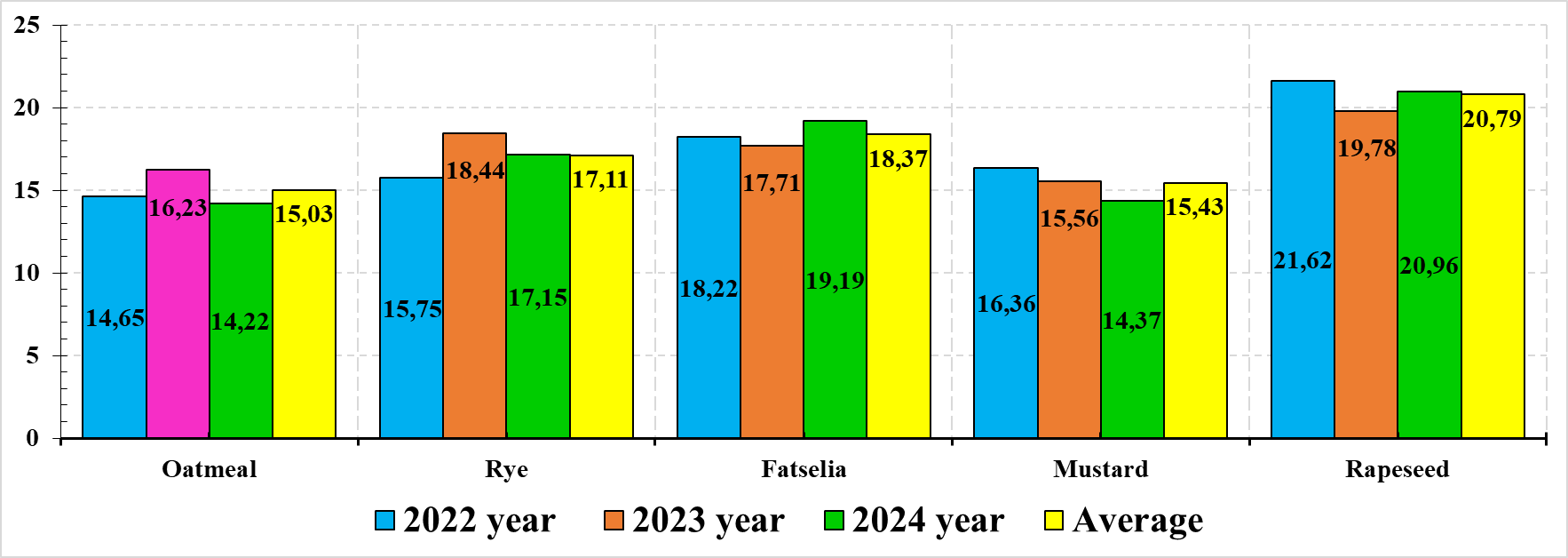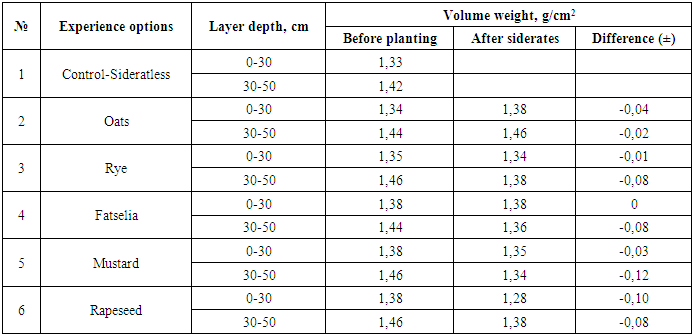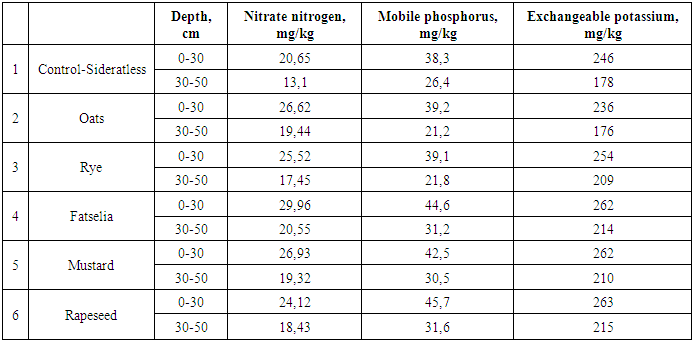-
Paper Information
- Paper Submission
-
Journal Information
- About This Journal
- Editorial Board
- Current Issue
- Archive
- Author Guidelines
- Contact Us
International Journal of Genetic Engineering
p-ISSN: 2167-7239 e-ISSN: 2167-7220
2024; 12(6): 146-150
doi:10.5923/j.ijge.20241206.16
Received: Dec. 12, 2024; Accepted: Dec. 27, 2024; Published: Dec. 31, 2024

Improving the Properties of Irrigated Gray-Meadow Soils with the Help of Siderate Crops
Mokhinur Musurmanova 1, Shakhobiddin Turdimetov 2
1PhD Student, Gulistan State University, Uzbekistan
2Professor, Doctor of Biological Sciences (DSc), Department of Agro-soil Science and Land Reclamation, Gulistan State University, Uzbekistan
Correspondence to: Mokhinur Musurmanova , PhD Student, Gulistan State University, Uzbekistan.
| Email: |  |
Copyright © 2024 The Author(s). Published by Scientific & Academic Publishing.
This work is licensed under the Creative Commons Attribution International License (CC BY).
http://creativecommons.org/licenses/by/4.0/

The article presents the results of scientific research aimed at improving the fertility of irrigated gray-meadow soils in the Mirzachul oasis through the application of green manure crops. The study found that planting green manure crops led to the enrichment of soils with organic residues and a modest increase in humus content. This aligns with findings reported by Bhatia and Sindhu [1], who highlighted the role of sustainable management of organic agricultural wastes in enhancing nutrient availability, mitigating pollution, and boosting crop production. The results further indicated a decrease in soil density, improved porosity, and positive changes in the levels of mobile nutrients. Consequently, the yield of crops planted after green manure crops increased significantly, demonstrating the ecological and economic benefits of this agricultural practice.
Keywords: Humus, Nitrogen, Phosphorus, Potassium, Siderates, Oats, Rye, Fatselia, Mustard, Rapeseed, Soil density, Soil porosity
Cite this paper: Mokhinur Musurmanova , Shakhobiddin Turdimetov , Improving the Properties of Irrigated Gray-Meadow Soils with the Help of Siderate Crops, International Journal of Genetic Engineering, Vol. 12 No. 6, 2024, pp. 146-150. doi: 10.5923/j.ijge.20241206.16.
1. Introduction
- Improving soil fertility through the use of plant resources represents an ecologically sustainable and economically efficient approach. This method minimizes environmental harm while lowering the production costs of agricultural products. The application of green manure crops, in particular, has gained attention for its multiple benefits in enhancing soil properties and agricultural yields.Several studies have explored these benefits. For instance, Sharma et al. [1] demonstrated that planting green manure crops enriches soil with phosphorus, increases organic residues, and enhances the formation of water-resistant microaggregates. Similarly, Sullivan [2] examined the impact of vetch as a green manure crop on maize yield, reporting that the costs of planting green manure crops were offset by increased maize production. The improved soil properties led to higher maize yields over successive years.Research by Mishchenko et al. [3] investigated the effects of different green manure crops on potato yield and weed suppression. Their findings revealed that oilseed radish significantly reduced weed infestation, with an inverse correlation observed between oilseed radish phytomass and weed density.In the context of the Mirzachul oasis, previous studies have focused on soil properties and the productivity of soils formed under diverse geomorphological conditions [4-10]. These studies noted substantial variation in the physical and agrochemical characteristics of the soils, influenced by natural and climatic conditions. Batirov, Turdimetov, and Nurillaeva [11] highlighted the ecological role of siderat (green manure) crops, emphasizing that their combined application was more effective than individual use. Additionally, research on irrigated grassland soils in the Mirzachul oasis found that the effectiveness of green manure crops was particularly pronounced in soils with low productivity [12-17].This paper builds on these findings, focusing on the potential of green manure crops to enhance soil productivity in the Mirzachul oasis. By addressing the ecological and economic aspects of this method, the study aims to provide actionable insights for sustainable agriculture in regions with varying soil conditions.
2. Research Object and Methods
- The research was conducted on irrigated meadow soils in the old irrigated part of the Mirzachul oasis, located in Uzbekistan. The Mirzachul oasis is situated in Central Asia and is characterized by its arid climate and predominantly gray-meadow soils, which have been historically developed through extensive irrigation practices. This region serves as an important agricultural zone, with soils that require continuous fertility improvement to sustain productivity.When selecting the research site, priority was given to areas representative of the typical soil characteristics of the Mirzachul oasis. The study was designed to evaluate the effects of planting siderat (green manure) crops on soil properties. Prior to planting, the physical and agrochemical properties of the soils were analyzed, including parameters such as soil density, porosity, and nutrient content. After harvesting the green manure crops, these properties were re-evaluated to assess the impact of the siderats.The following crops were used as siderats in the study: oats (Avena sativa), rye (Secale cereale), phacelia (Phacelia tanacetifolia), mustard (Sinapis alba), and rapeseed (Brassica napus). These crops were selected based on their suitability for the soil and climate conditions of the region, as well as their known effectiveness in improving soil fertility. The results of the study provided insights into the potential of these green manure crops to enhance soil properties and productivity in the Mirzachul oasis.
3. Results
- The importance of root and shoot residues in improving soil properties is important. Plant remains in the soil are the main source of organic matter and enrich the soil with nutrients and humus. Due to plant remains, the soil becomes soft, the amount of agronomically valuable aggregates increases, biological activity increases, favorable water-air properties and oxidation-reduction conditions are formed. Below is information on the amount of biomass remaining in the soil as a result of planting siderate crops (Figure 1).
 | Figure 1. The amount of biomass remaining under the influence of siderates, t/ha (2022-2024 years) |
|
|
4. Discussion
- The findings of this study highlight the significant potential of siderate (green manure) crops to improve the fertility and physical properties of irrigated gray-meadow soils in the Mirzachul oasis. The incorporation of these crops not only enriches the soil with organic residues but also contributes to sustainable agricultural practices by reducing reliance on chemical inputs.The results demonstrate that planting siderate crops led to an increase in humus content and improved soil structure, including reduced soil density and enhanced porosity. Among the crops studied, rapeseed showed the most pronounced effects, contributing the highest amount of biomass and leading to substantial improvements in the soil's physical and agrochemical properties. This aligns with previous research, which has emphasized the role of biomass in enriching soils with essential nutrients and promoting agronomic benefits.The study also revealed significant changes in mobile nutrient levels under the influence of siderates. For instance, the amount of mobile phosphorus increased notably in the rapeseed-planted variant, indicating the crop’s ability to enhance phosphorus availability in carbonate-rich soils typical of the Mirzachul oasis. Similar improvements were observed in the levels of exchangeable potassium and nitrate nitrogen, particularly in the Phacelia and mustard variants. These findings corroborate the role of siderate crops in mobilizing soil nutrients and improving nutrient cycling, as reported in earlier studies [1,2].Despite these benefits, the adoption of siderate crops in agricultural practices remains limited. This study underscores the ecological and economic advantages of using siderates, including reduced production costs and enhanced crop yields. The increase in crop yield following the incorporation of siderate crops highlights their role in creating a favorable environment for subsequent crop growth.However, the effectiveness of siderate crops can vary depending on local soil and climatic conditions. For example, while rapeseed proved highly effective in this study, other crops such as oats and rye showed comparatively lower impacts on soil properties. This variability suggests the need for site-specific recommendations when integrating siderate crops into farming systems.Future research should explore the long-term effects of siderate crops on soil fertility and productivity, as well as their interactions with different crop rotation systems. Additionally, efforts should focus on raising awareness among farmers about the benefits of green manure crops and providing practical guidelines for their effective use.
5. Conclusions
- The cultivation and incorporation of siderate crops into the soil during their flowering period yield significant benefits to soil properties and overall agricultural sustainability. Specifically, siderate crops enhance the soil's structure, improve its phytosanitary condition, and enrich it with essential nutrients, creating a more favorable environment for subsequent crop growth. These improvements in soil health lead to increased crop yields, which directly benefit agricultural productivity and food security. Furthermore, the use of siderate crops contributes to sustainable agricultural practices by reducing the reliance on chemical fertilizers and pesticides, thereby lowering production costs for farmers. This approach not only ensures the cultivation of environmentally friendly and healthier products but also aligns with global efforts to promote eco-friendly agricultural techniques. By integrating siderate crops into farming systems, it becomes possible to achieve a balance between economic efficiency and environmental conservation, paving the way for the production of affordable, high-quality, and ecologically sustainable food products. In summary, the strategic use of siderate crops offers a multifaceted solution to soil fertility enhancement, sustainable farming, and the production of safe and cost-effective agricultural goods, making it an indispensable practice for modern agriculture.
 Abstract
Abstract Reference
Reference Full-Text PDF
Full-Text PDF Full-text HTML
Full-text HTML
